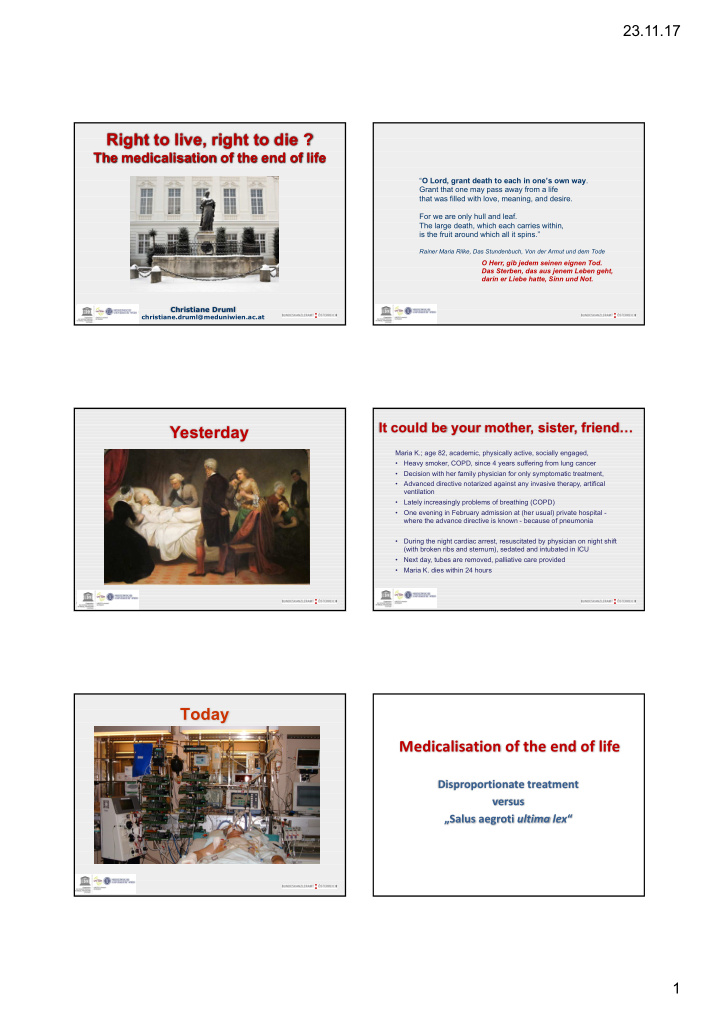



23.11.17 Right to live, right to die ? The medicalisation of the end of life “ O Lord, grant death to each in one’s own way . Grant that one may pass away from a life that was filled with love, meaning, and desire. For we are only hull and leaf. The large death, which each carries within, is the fruit around which all it spins.” Rainer Maria Rilke, Das Stundenbuch, Von der Armut und dem Tode O Herr, gib jedem seinen eignen Tod. Das Sterben, das aus jenem Leben geht, darin er Liebe hatte, Sinn und Not. Christiane Druml christiane.druml@meduniwien.ac.at CD 2017 CD 2017 It could be your mother, sister, friend… Yesterday Maria K.; age 82, academic, physically active, socially engaged, • Heavy smoker, COPD, since 4 years suffering from lung cancer • Decision with her family physician for only symptomatic treatment, • Advanced directive notarized against any invasive therapy, artifical ventilation • Lately increasingly problems of breathing (COPD) • One evening in February admission at (her usual) private hospital - where the advance directive is known - because of pneumonia • During the night cardiac arrest, resuscitated by physician on night shift (with broken ribs and sternum), sedated and intubated in ICU • Next day, tubes are removed, palliative care provided • Maria K. dies within 24 hours CD 2017 CD 2017 Today Medicalisation of the end of life Disproportionate treatment versus „Salus aegroti ultima lex “ CD 2017 1
23.11.17 Place of death A prospective determination of the incidence of persons over 65 years perceived inappropriate care in critically ill patients Singal RK. et al. Can Respir J 2014;21(3):165-170 . Perceived p process i issues l leading t to i inappropriate l life- Perceived r responsible p parties f for i inappropriate pr prolonging Where do people die? An international comparison of the percentage life-pr li prolonging trea tr eatm tmen ent. t. of deaths occurring in hospital and residential aged care settings. tr trea eatm tmen ent. t. Broad JB et al; Int J Public health, 2013 CD 2017 CD 2017 Causes for disproportionate treatment Disproportionate treatment • Therapeutic ambition “ It is a clear and undisputed principle that treatments • Justified and unjustified fear of legal consequences which are • not (or no longer) indicated or • Service invoicing logistics at the hospital • treatments which the patient refuses must not be • Lack of communication within the healthcare team performed. • Lack of communication between healthcare team and patient There are still cases where disproportionate treatment is • Relatives request therapy initiated. • Patient requests therapy This results in diagnostic, therapeutic or care-related interventions whose benefit for the individual patient is highly Disproportionate treatment is incompatible with two ethical questionable and which may expose the patient to a stressful principles, the principle of non-maleficence and the principle of situation that becomes problematic.” justice. CD 2017 CD 2017 Austrian Bioethics Commission Recommendations I Prevention of disproportionate medical interventions • Medical interventions which provide no benefit for the patient or which are more burdensome than potentially beneficial to the patient, and which may lead to a prolongation of the dying process in end-of-life situations, are ethically and medically unjustified because they come at a disproportionate burden. • The legal conditions for complex end-of-life decisions should take due account of this fact to allow for carefully weighed decisions without fear of criminal 2011 2015 prosecution. www.bka.gv.at/bioethik CD 2017 CD 2017 2
23.11.17 Recommendations II Recommendations III The terminology Trust and legal certainty in cases of limitation or discontinuation of The two following aspects are of crucial importance: medical measures which are no longer justified has to be established and to be exempted from legal punishment, when • The outdated and imprecise terms “active and passive euthanasia” need to be revised in accordance with the • The therapeutic decision is based on a comprehensible, substantiated “Recommendations for the terminology of medical and to the individual situation corresponding decision-making process. decisions in end-of-life situations” released by the Bioethics • ethical standards and guidelines by professional associations; academic Commission. ethical institutions or supranational institutions are followed. • This shall be taken into particular account in the education • Adherence to decision-making process is guaranteed. and training programs for the legal and medical professions. Compliance with clear guidelines should lead to the presumption of trust and to legal certainty for the treating physician. CD 2017 CD 2017 Confusion of terminology in Planning for end-of-life care decisions German language (living will, power of attorney, guardianship, …) Advance planning of medical end-of-life decisions shall be promoted through the following initiatives: • reducing the formal and financial hurdles to the establishment of legally binding living wills and powers of attorney Wallner J, • defining and checking quality standards and qualifications to assure proper information of healthcare Finding the right words for and legal professionals medical decisions at life's end • raising public awareness through a national program Wien klin Wochenschr 2008 CD 2017 CD 2017 Terminology of end of life decisions Do we need to change? Do we need a new culture for the end of life? For dying in „one‘s own way“? NAZI-EUTHANASIE = Murder CD 2017 3
23.11.17 Doctors‘ Personal End-of-Life Respect of the patients‘ will Preferences Appropriate care for the patient CD 2017 CD 2017 Thank you for your attention! www.josephinum.ac.at CD 2017 4
Recommend
More recommend